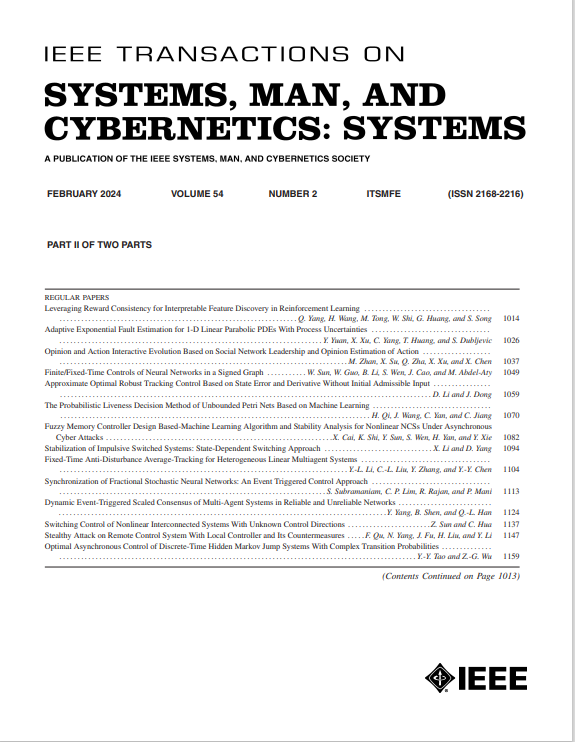Dissipativity Analysis and Bumpless Transfer Control for Synchronization of Switched Delayed Neural Networks: A Modified Combined Switching Approach
IF 8.7
1区 计算机科学
Q1 AUTOMATION & CONTROL SYSTEMS
IEEE Transactions on Systems Man Cybernetics-Systems
Pub Date : 2025-08-15
DOI:10.1109/TSMC.2025.3593877
引用次数: 0
Abstract
This investigation mainly focuses on the dissipativity analysis and bumpless transfer synchronization issue for switched delayed neural networks (SDNNs). To effectively leverage the past information of system states, a modified combined switching approach is creatively established, which offers a less conservative framework for the dissipativity analysis of SDNNs. By constructing a new time-dependent multiple Lyapunov–Krasovskii functional (TDMLF), sufficient conditions are then developed to ensure the strict切换延迟神经网络同步的耗散分析与无碰撞传递控制:一种改进的组合切换方法
本文主要研究了交换延迟神经网络(sdn)的耗散分析和无碰撞传输同步问题。为了有效地利用系统状态的过去信息,创造性地建立了一种改进的组合交换方法,为sdn的耗散分析提供了一个更保守的框架。通过构造一个新的时变多重Lyapunov-Krasovskii泛函(TDMLF),给出了确保所考虑的sdn具有严格的$(\mathscr {X}_{1}, \mathscr {X}_{2},\mathscr {X}_{3})$ - $\gamma $耗散性的充分条件,即使在所有子网都是非耗散的情况下也是如此。随后,将该方法用于sdn的同步,其中首先采用无碰撞传输类比例积分(PI-like)控制方法。此外,还提出了相应的判据,保证闭环同步误差系统(SESs)不仅满足严格的耗散性,而且具有一定的无碰撞传输性能。最后,通过两个仿真算例充分验证了所提设计方法的实用性和优越性。
本文章由计算机程序翻译,如有差异,请以英文原文为准。
求助全文
约1分钟内获得全文
求助全文
来源期刊

IEEE Transactions on Systems Man Cybernetics-Systems
AUTOMATION & CONTROL SYSTEMS-COMPUTER SCIENCE, CYBERNETICS
CiteScore
18.50
自引率
11.50%
发文量
812
审稿时长
6 months
期刊介绍:
The IEEE Transactions on Systems, Man, and Cybernetics: Systems encompasses the fields of systems engineering, covering issue formulation, analysis, and modeling throughout the systems engineering lifecycle phases. It addresses decision-making, issue interpretation, systems management, processes, and various methods such as optimization, modeling, and simulation in the development and deployment of large systems.
 求助内容:
求助内容: 应助结果提醒方式:
应助结果提醒方式:


